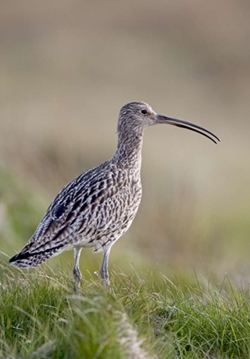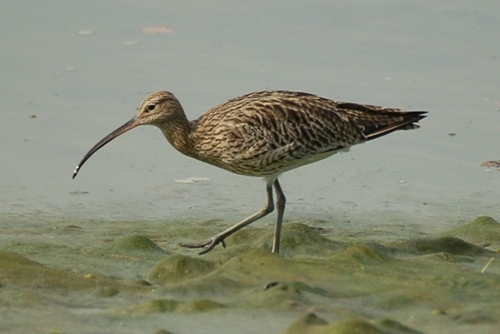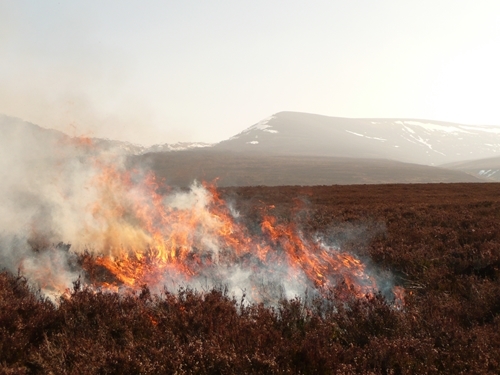 Q: How many curlew species are there in the world?
Q: How many curlew species are there in the world?
A: Eight: whimbrel, slender-billed curlew, Eurasian curlew, longbilled curlew, Far Eastern curlew, little curlew, Eskimo curlew and bristle-thighed curlew.
Q: Which one is the most commonly seen in the UK?
A: The largest one: Eurasian curlew (Numenius arquata) [hereafter “curlew”].
Q: Is it true that two of these are already extinct?
A: Two curlew species, the Eskimo and slender-billed, are at least critically endangered, probably already extinct.
Q: Is the curlew a species of conservation concern?
A: Yes. The UK breeding population has declined by 62% (1969-2015), therefore curlew are red-listed in the UK. Internationally, curlew are classified as ‘near threatened’.
Q: What does ‘near threatened’ mean?
A: This means that they almost qualify for the next category, which is ‘vulnerable’, or are likely to qualify for it in the near future. ‘Vulnerable’ species are facing a high risk of extinction in the wild.
Q: Is it true that curlew are the bird of highest conservation concern in the UK?
A: Staff from the RSPB, SNH, JNCC and Natural England published a paper in British Birds arguing that the curlew should be considered the UK’s most pressing bird conservation priority.
Q: How many breeding pairs of curlew are there in the UK?
A: 59,000 pairs. This is 25% of the world’s breeding population. In addition, a number of young, non-breeding curlew spend the summer in the UK.
Q: Where do curlew breed in the UK?
A: Historically, all over the country. Across our marshes, meadows, heathland and in arable fields. However, since their decline, curlew largely breed in the upland areas of the Pennines, the North York Moors, the southern uplands and eastern Highlands of Scotland, and the Northern Isles. A small number breed in lowland grassland, heathland and wetlands. Curlew are at their breeding sites between March and July.
Q: Do they return to the same breeding sites?
A: Yes. Adult curlew tend to be site-faithful, returning year after year, with chicks establishing their own nesting grounds close to where they themselves were fledged.
Q: Where do curlew overwinter in the UK?
A: Curlew travel to coastal areas of the UK after breeding, from July onwards. Numbers build up throughout winter to a peak in January/February before they return to their breeding areas.
Q: Where are the most important coastal areas for curlew in the UK?
A: Morecombe Bay, the Solway, the Wash and the Dee.

Q: How many curlew spend the winter in the UK?
A: 150,000 individual birds overwinter around the UK coastline. This is approximately 20% of the global population.
Q: Are these winter birds the same ones that breed here?
A: Some of them are. Similar to woodcock, the UK has resident birds and migrant birds. Within Europe, curlew generally migrate from their breeding sites to wintering sites further south and west. Resident birds move between sites within the UK; migrant birds move between countries.
Q: Why are these breeding and overwintering percentages different?
A: As with many species, curlew travel between countries to their preferred breeding and wintering sites. A large number of breeding birds leave the UK to travel to Ireland, France, Spain and other countries in winter. Other birds arrive to winter in the UK from breeding grounds in Scandinavia and Russia.
Q: Are curlew that overwinter in the UK in decline?
A: Overwintering curlew numbers have shown a decline over the most recent decade, however longer-term estimates remain stable.
Q: Where should we focus our conservation efforts?
A: Breeding curlew are showing declines, whilst overwintering birds are not, so arguably this places breeding habitat at the top of the conservation priorities for curlew.
Q: What breeding habitat do curlew need?
A: Curlew prefer areas with a mixed ground vegetation structure, to provide suitable cover but allow watchfulness for predators. They also choose areas with dry nesting sites close to wet areas for feeding. This translates to: open moorland, rough and damp pastures with rushes, unimproved hay meadows, and boggy ground; they occasionally use arable crops and silage fields.
Q: Is this habitat under threat?
A: Habitat loss is a major problem for curlew, with intensification of agriculture, urbanisation, changes in management of uplands, afforestation, and changes in wetlands all identified as important factors. However, large areas of apparently suitable habitat can be found with few, if any, curlew. Here, we suspect that predation of eggs and chicks has limited population size.
Q: But don’t forests provide good habitat for wildlife?
A: The conversion of moorland to forestry may be beneficial for some birds such as carrion crows, blackbirds and blue tits, but it can greatly damage existing upland bird populations. Curlew and other wader species are known to do less well close to afforested areas. This is probably due to the direct effects of habitat loss, and also indirect effects, such as increased predators sheltering in the woodland edges near nesting sites.
Q: Where do grouse moors fit in to curlew breeding success?
A: Moorland and upland farmland are important breeding habitats for curlew, and grouse moors are key within this. In the mid-1990s, the density of curlew was found to be twice as high on grouse moors as non-grouse moors.
Q: Why do curlew do better on grouse moors?
A: There are probably several reasons, including the legal control of predators undertaken by gamekeepers, and habitat management. We have shown experimentally that curlew breed three times more successfully on moors with predator management, and that breeding numbers increase when predator control is implemented and decline where it is not. Curlew also do better in areas with more gamekeepers.
Q: Does heather burning have a beneficial effect for curlew?
A: It may do. Some studies suggest that burning has a positive effect on curlew, however others have found no relationship. Heather burning does result in a mixed vegetation structure, which we know is beneficial for curlew. The RSPB website states that small-scale rotational burning of heather provides preferred nesting areas for curlew.

Q: How many curlew breed on grouse moors?
A: Although multiple studies suggest that curlew thrive on grouse moors, there is not yet a UK-wide estimate of the population on land managed by gamekeepers. We do know that 74% of the upland Special Protection Area in England is managed as grouse moor, therefore if this land management were lost, it would probably have negative population impacts. The ten-year GWCT Upland Predation Experiment indicates that curlew numbers would fall by 47% in a decade if gamekeepers stopped controlling generalist predators, even if the habitat was maintained.
Q: Are grouse moors important only for curlew?
A: No. As well as benefitting red grouse and curlew, GWCT research shows that lapwing, golden plover and meadow pipit also fledge more young birds on grouse moors that unkeepered moors. About 90% of the remaining black grouse in England survive on the fringes of managed grouse moors, sharing very similar habitats with the curlew.